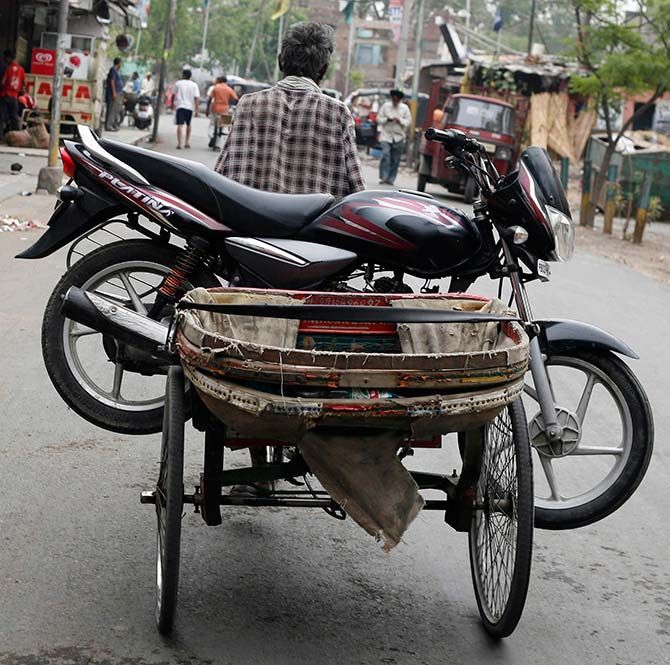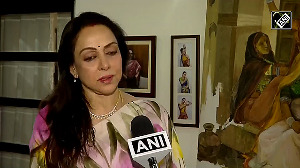
Unlike in the West, in India we do not see income inequality and all its ramifications as a topic worth debating, writes Ajit Balakrishnan.
You cannot be in New York for more than a few days without encountering a debate about inequality. On the day I got into the city last week, for instance, there were many different articles in The New York Times on the subject of inequality.
One, for example, pointed out that historically, young families buying their first homes have been a big driver of economic growth by creating construction jobs, demand for cement, steel, refrigerators, furniture and a hundred other things; but young people no longer have wages and salaries high enough to be able to buy homes.
Whatever income growth has happened is not from the growth of wages and salaries but from the growth of income that only people who are already well-to-do have: income from dividends and capital gains and other such 'investment income'.
I could not but wonder why in India, even the liberal segment of our media does not see income inequality and all its ramifications as a topic worth debating.
Media outlets in India worry more about painting gory pictures about financially 'corrupt politicians' or 'lazy babus'.
Perhaps income inequality is so much a part of the Indian landscape that we never see it as a 'problem', it is probably seen as a fact of life, an ever-present condition that requires no explanation.
Thomas Piketty, the French economist, reminds us in his book The Economics of Inequality that a family’s income can come from five different sources: wages/salaries if one or more members of the family are currently working; self-employment earnings if they run a shop or a profession or a small business; from returns on investments or rent from property; from pensions; or from unemployment insurance.
Families differ in the proportion that each of these sources contributes to their total income.
Families that have been historically wealthy, for example, would have a high proportion of their income from returns on investments.
One way to measure economic inequality is to check how much more the highest 10 per cent of the families, in terms of income, in a country make than the families in the lowest 10 per cent.
This ratio for the United States is 16 according to United Nations statistics; that is to say, families who in the highest 10 per cent in family income make 16 times more than families in the lowest 10 per cent.
European countries tend to be more egalitarian: this ratio for France is nine and for Germany seven.
And India, hold your breath, a hard-to-believe eight.
So the American liberal media like The New York Times may not be quite ranting when they write so obsessively about economic inequality in the United States.
When Prof Piketty studied the trend of this ratio over time, he found that for his native France, at the start of the 20th century, the vast majority of families in the top 10 per cent got their income from letting out property on rent.
As the century progressed, however, and you got to the 1950s, the wage-earners were equal in number to the rentiers in this top 10 per cent.
This trend is probably true in India too.
Landowners who leased out their land to tenant farmers probably dominated India’s top 10 per cent of families by income at the start of the 20th century, and their status has declined steeply since then.
What types of families are at what level of income seems to be determined as much by sociology as it is by economics. For example, Prof Piketty says that, in the United States, the top 10 per cent nowadays is dominated by the 'working rich', not landlords and rentiers.
And within this working rich, he reports that high earners often have spouses who are also high earners; in other words, high earners seem to be seeking out and marrying other high earners. On the other end of the scale, the lowest earning 10 per cent is dominated by single women with children.
In Prof Piketty’s other book, Capital in the Twenty-First Century, he makes a strong case for steeply progressive wealth and income taxes, which sounds like a return to socialism; but the mere fact that his book published a year or so ago has so far sold over 1.5 million copies in French, English, German, Chinese and Spanish shows how the topic of inequality is resonating worldwide.
India’s public discourse probably needs to debate this issue more than we have had so far.
The story about the rise of some types of families and the fall of others has so far figured only as the story about the declining fortunes of landed families: remember Guru Dutt’s Sahib Bibi Aur Ghulam, and Satyajit Ray’s Jalsaghar, to name just two. We need to expand this debate.
Image used for representational purpose only. Photograph: Reuters.
Ajit Balakrishnan, the founder and CEO of rediff.com, is the author of The Wave Rider: A Chronicle of the Information Age. He can be reached at ajitb@rediffmail.com












 © 2025
© 2025